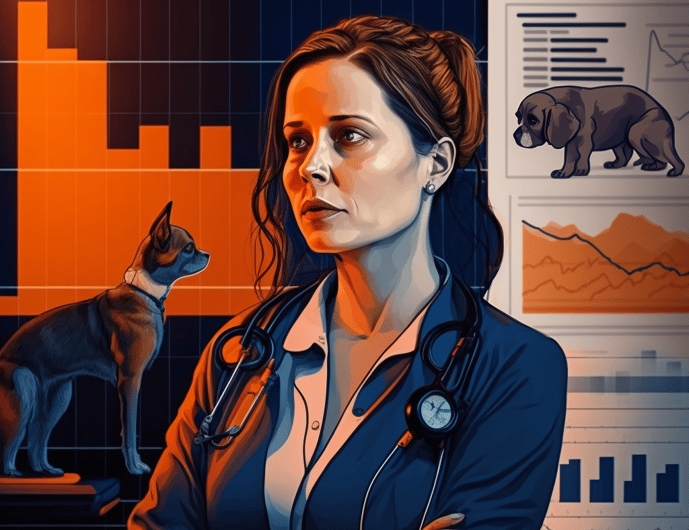Strength is vital during times of uncertainty

The old ways are comfortable. We know what to expect, and thus we’re able to plan. But what happens when the world changes and uncertainty casts doubt into our decisions?
We often refer to this as a period of disruption, a word that connotes a disturbance, a problem, a departure from the norm. Instead of allowing disruption to launch us into indecision — to crack our world view — let’s instead view it positively through a future-focused lens. We can look through that lens and into the cracks to see new and different ways.
To reach a port we must sail, sometimes with the wind, and sometimes against it. But we must not drift or lie at anchor. – Oliver Wendell Holmes, Sr.
It’s within this context that I challenge us to inject some disruption into the veterinary industry. This is especially important with two of the key challenges we face: inflation and the labor shortage.
Rising costs cut into care
First, inflation. Veterinary services experienced an average inflation rate of 4.5% per year between 1997 and 2021, according to the U.S. Bureau of Labor Statistics (BLS). Compared to the normal U.S. inflation rate of 2.15% during this same period, this rate of change indicates significant inflation. To illustrate, veterinary services costing $100 in 1997 would cost $287.38 in 2021 for an equivalent purchase. If the costs rose with the normal inflation rate, the 2021 cost should be just $164.31.
“Veterinary prices have strongly inflated for years, resulting in a reduction in visit frequency,” says a July 2022 Pet Age article. While higher prices for pet care led to deserved higher wages for veterinarians and teams, less care for fewer pets is an unfortunate result. New businesses, payment options and veterinary care models are already disrupting traditional methods so more people can get veterinary care that fits their family’s budget.
Staff shortage shorts patients
Next is the labor shortage. Stacy Pursell, founder and CEO of The VET Recruiter, wrote a recent article stating that the veterinarian shortage is about to become even more severe. She bases her takeaway on data from the BLS:
“In April of [2022], the BLS projected that veterinarian jobs will grow by 17% between 2020 and 2030. In September, the Bureau adjusted those numbers. Now the BLS is projecting that veterinarian jobs will grow by 19% between 2021 and 2031. According to a report released by Mars Veterinary Health earlier this year, this would translate into a shortage of 15,000 veterinarians by the end of the decade.”
We won’t be able to overcome this deficit without disruption. Looking through the disruptive cracks that have already formed, I see the Royal Veterinary College in the United Kingdom and their five-year bachelor of veterinary medicine (BVetMed) program, which entitles students to practice as a veterinarian immediately upon earning the degree.
I also see the master’s degree pilot program at Lincoln Memorial University College of Veterinary Medicine in Tennessee. It creates a midlevel veterinary professional. Could its impact free up veterinarians while also encouraging veterinary technicians to remain in the profession?
Telemedicine is yet another disruption. Re-evaluating the veterinarian-client-patient relationship (VCPR) is another way to allow veterinarians to meet patients where they are and engage in those virtual consultations. Not for everything of course. Virtual surgeries? No, thank you. But for post-care checkups and emergency check-ins? Yes, please.
2022 volatility and 2023 uncertainty
Often referred to as “recession-proof” and “pandemic-resistant,” the animal health industry is not without its bumps and bruises. Rising interest rates are impacting company financials at all levels of the industry. Inflation, as referenced earlier, is adding stress and uncertainty for the consumer. Will this continue into the next year? No one knows for sure, but what we can expect is continued opportunity for disruption.
And this is where it’s critical to engage a strong partner. One who will help you sail through those violent times and remain focused on value creation.
Disruption for progression
All this points to the idea that if we want the veterinary industry to continue growing — even through challenging times — we must change. The current model is at a breaking point. Change will happen to us, or we will lead it with deliberate, smart choices.
Let’s address these challenges now from a place of strength, partnership and some healthy disruption. Because disrupting the old ways is the only way forward.
Patrick Sweet is co-chief executive officer of Stephens & Associates.
Sources:
Christiansen B. Is the Veterinary Profession Serving All Companion Animal Medical Needs in America Today? A Case for Full-Service, Low-Cost, Non-Profit Community Veterinary Care Centers. 2021. The Boca Fund, Inc. https://bocafund.com/wp-content/uploads/2021/06/ExecSummary.pdf Accessed Nov. 28, 2022.
Petflation: Veterinary prices have strongly inflated for years, resulting in a reduction in visit frequency. Pet Age. July 18, 2022. https://www.petage.com/petflation-june-update-reveals-inflations-impact-on-pet-industry Accessed Nov. 28, 2022.

